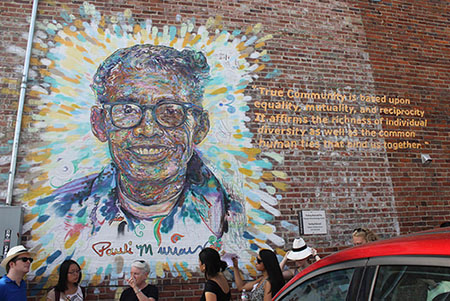Murray, Anna Pauline (Pauli)
20 Nov.1910 - 1 Jul. 1985
By Ansley Wegner, Research Branch, NC Office of Archives and History, 2010; Revised by SLNC Government and Heritage Library, January 2023
NC Highway Historical Marker Program
See also: Pauli Murray for K-8 Students; Fitzgerald, Robert George
 Anna Pauline (Pauli) Murray, lawyer, professor, writer, outspoken civil and gender rights activist, and Episcopal priest, was born in Baltimore. When she was three years old, her mother died and, as her father was confined to a state hospital, she went to live with her aunt, and namesake, Pauline Fitzgerald Dame of Durham. She graduated at sixteen from segregated Hillside High School as valedictorian.
Anna Pauline (Pauli) Murray, lawyer, professor, writer, outspoken civil and gender rights activist, and Episcopal priest, was born in Baltimore. When she was three years old, her mother died and, as her father was confined to a state hospital, she went to live with her aunt, and namesake, Pauline Fitzgerald Dame of Durham. She graduated at sixteen from segregated Hillside High School as valedictorian.
Murray enrolled at Richmond Hill High School in New York, the only black student, to complete high school. Determined to attend an integrated college, but unable to meet stringent requirements, academic and financial, at Barnard, she matriculated at Hunter College. She worked briefly at Camp Tera, a New Deal work project, there meeting Eleanor Roosevelt, who would be a guiding force in her life.
In 1938 she applied to the University of North Carolina to study sociology. Her application, against state law which required “separate but equal” institutions, garnered national attention. Her unsuccessful campaign for admission was the first time that she experienced what she would later summarize in saying that one woman with a typewriter constitutes a movement.
Despite having served jail time for refusing to sit at the back of a bus in Virginia, Murray was admitted to Howard Law School in 1941 where she experienced discrimination due to her gender rather than her race. When awarded a fellowship to pursue advanced legal education, she was rejected by Harvard, again, because of her gender. She went to California to study for a master’s in law. Later she would wonder which was the bigger obstacle to her legal career, race or gender.
Murray published States' Laws on Race and Color in 1951. Thurgood Marshall called the work “the Bible for civil rights lawyers.” Her second book, a biographical account, was Proud Shoes: The Story of an American Family (1956). In 1960 she travelled to Ghana to teach law at the University of Ghana and later authored the first English-language textbook on law in Africa.
Murray worked for civil rights and women’s organizations, helped found the National Organization of Women (NOW), and was appointed by President John F. Kennedy to the Committee on Civil and Political Rights within his Commission on the Status of Women. She remained critical of the lack of leadership roles for women in many of the organizations. She published a volume of poetry, Dark Testament, in 1970.
In 1977 Murray became the first Black American female Episcopal priest in the United States, and held her first Eucharist at the Chapel of the Cross in Chapel Hill, where her grandmother had been baptized while she was enslaved. About the special day she wrote, "All the strands of my life had come together."
Pauli Murray died on July 1, 1985, in Pittsburgh. She is buried in Cypress Hill Cemetery, Brooklyn, New York. Her autobiography, Song in a Weary Throat: An American Pilgrimage, was published in 1987.
Educator Resources:
Grades K-8: https://www.ncpedia.org/pauli-murray-k-8
ANCHOR, Pauli Murray and 20th Century Freedom Movements: https://www.ncpedia.org/anchor/pauli-murray-freedom-movements
References:
Darlene Clark Hine, ed., Black Women in America (2005), II, 405-407.
Anne Firor Scott, ed., Pauli Murray and Caroline Ware: Forty Years of Letters in Black and White (2006)
Glenda E. Gilmore, Defying Dixie: The Radical Roots of Civil Rights, 1919-1950 (2008)
Additional Resources:
Pauli Murray Project. Duke Human Rights Center, the Franklin Humanities Institute. https://www.paulimurraycenter.com/ (accessed May 13, 2015).
Cooper, Brittney. Black, queer, feminist, erased from history: Meet the most important legal scholar you’ve likely never heard of: Ruth Bader Ginsburg is this Supreme Court's liberal hero, but her work sits on the shoulders of Dr. Pauli Murray. February 18, 2015. Salon. https://www.salon.com/2015/02/18/black_queer_feminist_erased_from_history_meet_the_most_important_legal_scholar_youve_likely_never_heard_of/
Pauli Murray's Writing (from the Pauli Murray Project, Duke Human Rights Center, the Franklin Humanities Institute)
“And the Riots Came.” The Call, Friday, August 13 1943, 1; 4.
“A Blueprint for First Class Citizenship.” The Crisis 51 (1944): 358-59.
Dark Testament and Other Poems. Norwalk, CT: Silvermine, 1970.
Human Rights U.S.A.: 1948-1966. Cincinnati, Service Center, Board of Missions, Methodist Church, 1967.
“Negro Youth’s Dilemma.” Threshold, April 1942, 8-11.
“Negroes Are Fed Up.” Common Sense, August 1943, 274-76.
Proud Shoes: The Story of an American Family. New York: Harper & Row, 1978.
“The Right to Equal Opportunity in Employment.” California Law Review 33 (1945): 388-433.
“Roots of the Racial Crisis: Prologue to Policy.” J.S.D., Yale University, 1965.
Song in a Weary Throat: An American Pilgrimage. New York: Harper & Row, 1987.
States’ Laws on Race and Color. Cincinnati: Women’s Division of Christian Service, Board of Missions and Church Extension, Methodist Church, 1951.
“Three Thousand Miles on a Dime in Ten Days.” In Negro Anthology: 1931-1934, edited by Nancy Cunard, 90-93. London: Wishart and Co., 1934.
“Why Negro Girls Stay Single.” Negro Digest 5, no. 9 (1947): 4-8.
Murray, Pauli, and Henry Babcock. “An Alternative Weapon.” South Today, (Winter 1942-1943): 53-57.
Murray, Pauli, and Mary O. Eastwood. “Jane Crow and the Law: Sex Discrimination and Title Vii.” George Washington Law Review 34, no. 2 (1965): 232-56.
Murray, Pauli, and Leslie Rubin. The Constitution and Government of Ghana. London: Sweet and Maxwell, 1964.
Image Credit:
Ma, Connie. [Pauli Murray mural, "True Community," Foster Street, Durham, N.C.]. Photograph. August 22, 2014. Flickr. https://www.flickr.com/photos/ironypoisoning/15472932724
13 May 2015 | Wegner, Ansley Herring